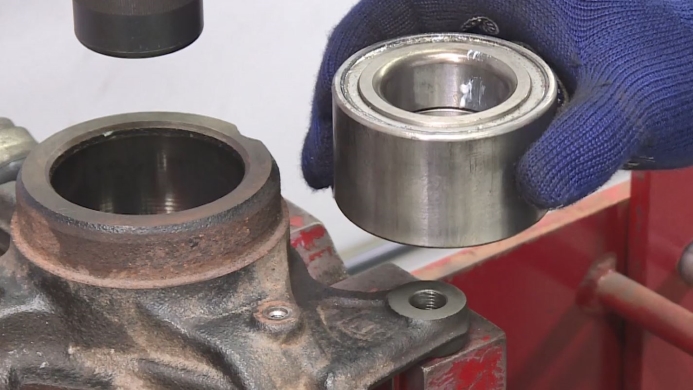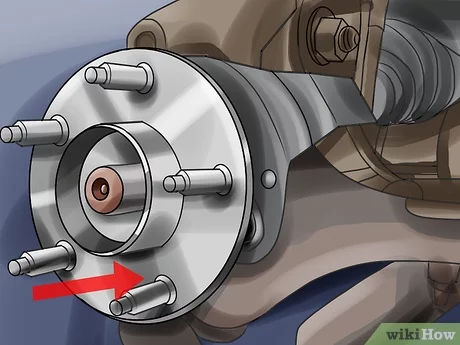When it comes to wheel bearing replacement, it’s crucial to ensure timely and proper maintenance to prevent potential safety hazards. Wheel bearing replacement is an essential part of vehicle maintenance that involves removing the old, worn-out bearings and installing new ones to ensure smooth and safe operation of the wheels.
Over time, wheel bearings can wear out due to constant use and exposure to the elements, leading to noise, vibration, and compromised handling. In this blog, we will explore the importance of wheel bearing replacement, signs that indicate it’s time for a replacement, and the benefits of timely maintenance.
Contents
What Are Wheel Bearings?
Wheel bearings are an essential component of a vehicle’s wheel assembly. They are small, metal balls or rollers enclosed within a metal ring called a bearing race. These bearings facilitate smooth and efficient rotation of the wheels, allowing the vehicle to move forward with ease.
Wheel bearings are typically made from high-quality steel or ceramic materials to withstand the intense pressures and constant friction experienced while driving. They are designed to withstand heavy loads and provide durability, ensuring the wheels can rotate smoothly for extended periods.
Significance In Vehicle Performance
The proper functioning of wheel bearings is crucial for optimal vehicle performance. Here’s why:
- Smooth Ride: Wheel bearings help reduce friction between the wheels and the axle, allowing the wheels to rotate smoothly. This results in a comfortable and vibration-free ride for the driver and passengers.
- Steering Responsiveness: Well-maintained wheel bearings contribute to precise steering control. They ensure that the wheels respond accurately to the driver’s input, enhancing overall handling and maneuverability.
- Enhanced Fuel Efficiency: By reducing friction, wheel bearings minimize the effort required for the wheels to rotate. This can lead to improved fuel efficiency since the engine doesn’t have to work as hard to move the vehicle forward.
- Longevity of Tires: Properly functioning wheel bearings distribute the weight of the vehicle evenly across the tires. This helps prevent uneven tire wear and extends the lifespan of the tires, saving you money in the long run.
Given their critical role in vehicle performance, it is important to regularly inspect and replace wheel bearings as needed. Over time, bearings may wear out due to constant use, exposure to harsh conditions, or lack of maintenance.

Credit: www.wikihow.com
Failing Wheel Bearings Symptoms
Recognizing the signs of failing wheel bearings is crucial for maintaining your vehicle’s safety and performance. Ignoring these symptoms can lead to serious damage and potential safety hazards. Keep an eye out for these common indicators that may signal the need for wheel bearing replacement.
1. Unusual Noises
One of the primary indicators of worn-out wheel bearings is the presence of unusual bearing noises emanating from the wheels. Listen for a persistent grinding, growling, or rumbling sound that intensifies as the vehicle accelerates or decelerates. This could indicate that the wheel bearings are deteriorating and in need of immediate attention.
2. Wheel Wobble
Another symptom of failing wheel bearings is the occurrence of wheel wobbling or vibrating while driving. If you notice a shaky or unstable sensation coming from the wheels, especially at higher speeds, it could be a clear indication of worn-out wheel bearings and may require prompt replacement to ensure safe driving conditions.
3. Uneven Tire Wear
Keep an eye out for uneven tire wear, as it can be a sign of failing wheel bearings. Inspect your tires for irregular tread patterns, which may indicate that the wheel bearings are not distributing the vehicle’s weight evenly. This can lead to premature tire wear and affect the overall handling and stability of the vehicle.
Choosing The Right Wheel Bearings
When it comes to wheel bearing replacement, choosing the right wheel bearings is crucial for ensuring a smooth and safe ride. Wheel bearings are responsible for supporting the weight of the vehicle and allowing the wheels to spin freely. A worn-out or damaged wheel bearing can result in a variety of issues, including excessive noise, vibrations, and even wheel detachment.
Types Of Wheel Bearings
There are two main types of wheel bearings commonly used in vehicles:
- Tapered Roller Bearings: These bearings are designed to handle both radial and axial loads. They are durable and can withstand heavy loads, making them suitable for trucks, SUVs, and other vehicles that carry heavy loads. Tapered roller bearings are commonly used in rear wheel drive vehicles.
- Ball Bearings: These bearings are lighter and more compact compared to tapered roller bearings. They are commonly used in front wheel drive vehicles and are suitable for lighter loads. Ball bearings provide smoother rotation and are less likely to generate heat.
Compatibility And Quality
When selecting wheel bearings, it is important to consider compatibility and quality:
- Compatibility: Ensure that the wheel bearings you choose are compatible with your vehicle’s make, model, and year. Consult the manufacturer’s specifications or consult with a professional mechanic to ensure a proper fit.
- Quality: Opt for high-quality wheel bearings from reputable manufacturers. Quality bearings are made from durable materials and undergo rigorous testing to ensure reliability and longevity. Investing in quality bearings can help prevent premature failure and costly repairs in the future.
Remember, replacing wheel bearings is a critical maintenance task that should be carried out by a qualified mechanic. They have the expertise and tools necessary to ensure proper installation and alignment, ensuring the safety and performance of your vehicle.

Credit: www.nskeurope.com
Wheel Bearing Replacement Guide
Embark on a hassle-free journey with our Step-by-Step Replacement Guide. Follow these easy steps to ensure a smooth and safe process.
Tools Needed
- Jack and jack stands
- Lug wrench
- Socket wrench set
- Bearing packer
- Rubber mallet
Removing The Old Bearings
1. Lift the vehicle using a jack and secure it on jack stands.
2. Unscrew the lug nuts using a lug wrench.
3. Remove the wheel and brake caliper to access the old bearings.
Installing New Bearings
- Prepare the new bearings by packing them with grease using a bearing packer.
- Install the new bearings by tapping them in place with a rubber mallet.
- Reassemble the brake caliper, wheel, and lug nuts.
After Replacement: Ensuring Longevity
After replacement, it’s crucial to ensure longevity. Regular maintenance and proper lubrication can extend the lifespan of the new bearings, preventing premature wear and tear. By following manufacturer guidelines and addressing any issues promptly, you can keep your vehicle running smoothly for the long haul.
Proper Maintenance Tips
Proper maintenance is key to ensuring the longevity of your wheel bearings. After replacing your wheel bearings, it’s important to keep them in good condition to avoid premature wear and tear. Here are some maintenance tips to help you keep your wheel bearings in top shape:
- Regularly check your wheel bearings for signs of wear and tear, such as grinding or clicking noises.
- Keep your wheels clean and free of debris, as dirt and grime can cause damage to your bearings.
- Ensure your wheels are properly aligned, as misalignment can cause uneven wear on your bearings.
- Use high-quality lubricants to keep your bearings properly lubricated and reduce friction.
- Replace your wheel bearings at regular intervals, as recommended by your vehicle manufacturer.
When To Inspect Wheel Bearings
Regular inspection of your wheel bearings is crucial for maintaining their longevity. Here are some signs that it’s time to inspect your wheel bearings:
- Unusual noises coming from your wheels, such as grinding, clicking, or humming sounds.
- Uneven tire wear, which can be caused by misaligned wheels or worn bearings.
- Difficulty steering or handling your vehicle, which can be caused by damaged or worn bearings.
- Excessive vibration or wobbling, which can be caused by worn or damaged bearings.

Credit: www.amazon.com
Frequently Asked Questions
Here are some FAQs about wheel bearing replacement –
How Much Should It Cost To Replace A Wheel Bearing?
The cost to replace a wheel bearing can range from $150 to $350 per wheel. Factors such as the make and model of the car, labor costs, and the type of wheel bearing can affect the overall price. It’s best to consult a mechanic for an accurate estimate.
Is It Ok To Drive With A Bad Wheel Bearing?
No, it is not safe to drive with a bad wheel bearing. A bad wheel bearing can cause various issues such as uneven tire wear, reduced steering control, and even complete wheel detachment. It is important to get it fixed as soon as possible to ensure your safety on the road.
Is A Wheel Bearing Easy To Replace?
Replacing a wheel bearing can be challenging and requires specific tools and knowledge. It’s not an easy task for inexperienced mechanics. A professional mechanic can replace a wheel bearing in around one to three hours, depending on the car’s make and model.
How Do I Know When My Wheel Bearings Need Replacing?
You’ll likely hear a growling or rumbling noise from the wheel area. Also, vibrating or shaky steering wheel can indicate worn wheel bearings.
Conclusion
Proper maintenance of wheel bearings is crucial for vehicle safety and performance. Regular inspections and timely replacements can prevent costly repairs and accidents. Trusting professional mechanics ensures a smooth and efficient process. Drive smoothly and confidently with well-maintained wheel bearings.
